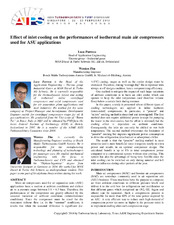| dc.contributor | Asia Turbomachinery & Pump Symposium (1st : 2016) | |
| dc.creator | Porreca, Luca | |
| dc.creator | Zhu, Wentao | |
| dc.date.accessioned | 2017-05-04T12:49:08Z | |
| dc.date.available | 2017-05-04T12:49:08Z | |
| dc.date.issued | 2016 | |
| dc.identifier.uri | https://hdl.handle.net/1969.1/160253 | |
| dc.description | Lecture | en |
| dc.description.abstract | Lecture 10: Main air compressors used for air separation units (ASU) applications have a suction at ambient conditions and deliver air to a pressure range between 5.6 ~ 6.5 bara. Therefore, the performances of the compressor are greatly affected by the seasonal variation of ambient conditions (winter/summer conditions). Since the compressor must be sized for the maximum volume flow i.e. in the “summer” conditions, it results that when the seasonal difference is significant (i.e >15°C) casing, stages as well as the cooler design must be oversized. Therefore, during “average day” the compressor runs always at off design condition, hence compromising efficiency. One method to mitigate the impact of such large variations of ambient conditions is to have an inlet cooler which can operate to keep the inlet temperature (and therefore volume flow) below a certain limit during summer. In this paper, a study is presented where different types of cooling technologies are applied in inline isotherm (intercooled) compressors. In particular, a “passive” and “active” cooling method is described and investigated. The first method does not require additional power (except for pumping the water in the inlet cooler, but the effort is minimal) but the cooling effect is dependent on ambient conditions. Consequently, the inlet air can only be chilled to wet bulb temperature. The second method overcomes the limitation of “passive” cooling but requires significant power consumption to drive the refrigeration (mechanical or adsorption) chiller. The result is that the “passive” cooling method is most attractive and is most beneficial since it requires nearly no extra power and results in an optimal compressor design. The calculated benefit is up to 1% in total compression power compared to a conventional system without inlet cooling. This system has also the advantage of being very flexible since the inlet cooling can be switched on only during summer and left with no influence during other periods of the year. | en |
| dc.format.medium | Electronic | en |
| dc.format.mimetype | application/pdf | |
| dc.language | en | |
| dc.publisher | Turbomachinery Laboratories, Texas A&M Engineering Experiment Station | |
| dc.relation.ispartof | Asia Turbomachinery & Pump Symposium. 2016 Proceedings. | en |
| dc.subject.lcsh | Turbomachines | en |
| dc.subject.lcsh | Pumping machinery | en |
| dc.title | Effect of Inlet Cooling on the Performances of Isotherm Main Air Compressor Used for ASU Applications | en |
| dc.type.material | Text | en |
| dc.identifier.doi | https://doi.org/10.21423/R1V70F | |


